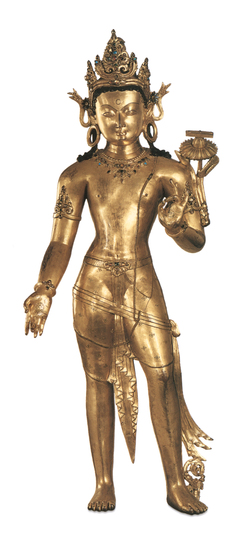
Item: Manjushri (Bodhisattva & Buddhist Deity) - Bodhisattva
| Origin Location | Nepal |
|---|---|
| Date Range | 1100 - 1199 |
| Lineages | Buddhist |
| Material | Metal, Mercuric Gild |
| Collection | Private |
Classification: Deity
Appearance: Peaceful
Gender: Male
Manjushri Nepal or Tibet circa 12th century Gilt copper with inset jewelry H 91.2 cm ZG 1020 Manjushri is represented in this important gilt copper sculpture as the Bodhisattva of Wisdom, identified by the emblem of a prajnaparamita sutra resting on the flower at his shoulder. Fire-gilt copper images of standing deities such as this define the Newar aesthetic in the late Transitional period (ca 879-1200 CE) and the beginning of the Early Malla period (1200-1482). Bodhisattvas are modelled as idealized youths adorned with jewelry and standing in graceful tribhanga. Fabulous sculptures such as the Manjushri captured the imagination of Tibetan patrons during the Chider, the ‘Later Diffusion’ of the Buddhist faith, corresponding to the period c. 1000–1200, as sculpture was sought to fill the halls of newly built monasteries in Central Tibet.
Similar large Nepalese style standing gilt copper sculptures representing the Eight Great Bodhisattvas are worshipped in Sera Monastery. Four large scale early Nepalese style gilt copper standing bodhisattvas are found in the Potala, Jokhang and Shalu. The Victoria and Albert Museum and the British Museum each have a large Nepalese style standing bodhisattva brought from Tibet in the early twentieth century and nineteenth century respectively. Numerous smaller examples of early Nepalese and Nepalese style gilt copper standing bodhisattvas are found throughout Tibetan monastery collections and private and museum collections worldwide, but this select group of early, intact and sizeable gilt copper standing sculptures, including the Manjushri, remains exceedingly rare.
The Manjushri is made with tangs beneath the feet to fit a separately made pedestal, and is cast in one piece — as are the Sera bodhisattvas — in a remarkable feat of foundry skill. The smooth tactile skin of the statue and sensuous sculptural form is testament not only to the artist’s prowess but the expertise of the craftsmen that finished the cast, whereby the surface of the statue is patched and burnished before the application and firing of the mercury amalgam gilding. The minimal wear to the gold suggests the statue has not been repeatedly handled over the years, perhaps protected on a high altar like the bronzes at Sera.
Subtle shades of green, blue and garnet colored stones are inset into the sumptuous jewelry, with lapis lazuli in the rosettes above the ears, turquoise, colored green glass and garnet-colored foil-backed crystal or glass in the crown, necklace, belt clasp, armbands and bracelets. The earrings, necklace and crown band have channels cast into the jewelry to receive strings of pearls — all now missing — that were secured in place by the still visible retaining wires evenly spaced along the length of the grooves. This typically Nepalese decorative device is observed on the cast gilt copper sculpture of Densatil where Newar craftsmen were known to have worked.
A beaded cord, ratnopavita, hangs over the left shoulder and follows the contours of the torso down to the thigh where it forms a loop over the sash that drapes the hips. This observation of the subtle movement of the sacred cord as it meets the sash is a classic feature of Nepalese Transitional period sculpture, and is seen on almost all standing bodhisattva statues of the period: the feature is less often seen in the Early Malla period. The crown style is typical of Transitional period sculpture with three jeweled elements attached to a head band with the tall central leaf dominant, and rosettes above the ears. The bud and scrolling tendril at the left foot is also typical of early Nepalese sculpture where the deity has a flower at the shoulder.
The aquiline nose and the full and protruding lower lip are features of early Nepalese art that are derived from classical Indian Gupta period (ca 320-550 CE) sculptural traditions espoused by Licchavi period (ca 400-879 CE) artists in Nepal. The sublime image of Manjushri epitomizes this timeless sculptural aesthetic of youth and beauty, and gracefully embodies the tenets of the prajnaparamita sutra that rests on the flower at his shoulder, the Perfection of Wisdom.
BIBL: Pratapaditya Pal, Himalayas: An Aesthetic Adventure, Chicago, 2003, p. 35, cat. no. 11.
( David Weldon )
文殊菩萨 尼泊尔或西藏 约12世纪 红铜鎏金 镶嵌宝石 高:91.2厘米 ZG1020
这是一尊非常重要的铜鎏金造像,文殊菩萨被塑造为智慧的菩萨,由他肩旁花朵上奉置的《般若波罗蜜多心经》可以辨识。 这类神像的样式与风格奠定了过渡时期晚期(约公元879-1200)和马拉王朝 (约公元1200-1482)初期的纽瓦尔美学,以优雅的站姿和华丽的装饰塑造出理想化的青年人形象。在佛教后弘期,约公元1000–1200年间在西藏中部新建寺院的各个殿堂中都供奉这类神像,而这尊精美绝伦的文殊菩萨立像正是体现了西藏佛教后弘期的艺术审美。
色拉寺有一组近似尺寸的大型尼泊尔风格铜鎏金八大菩萨立像,布达拉宫、大昭寺和夏鲁寺至今也保存着四尊大型的早期尼泊尔风格铜鎏金菩萨立像。维多利亚与阿尔伯特博物馆和大英博物馆分别收藏了一尊于20世纪初和19世纪时被人从西藏带来的大型尼泊尔风格的铜鎏金菩萨立像。在西藏的寺院、世界各地的博物馆和私人收藏中,可以见到较多小型的早期尼泊尔或尼泊尔风格的铜鎏金菩萨立像,但像这尊可以保存如此完好、体量如此高大的铜鎏金文殊菩萨立像,甚为罕见。
脚下有凸榫,整体铸造,可与单铸的底座相固定,这样的铸造工艺非同凡响,色拉寺内的八大菩萨立像也如此。极具美感的造型和极富质感的光滑肌肤,不止见证了艺术家的才华,还见证了完成铸造这件作品的工匠们的专业技术。鎏金是将金和水银合成金汞剂,涂在铜像表面,然后加热使水银蒸发,使金附着在表面不脱,但在鎏金之前需对造像进行修补与抛光。这尊大型文殊菩萨立像的鎏金层几乎没有磨损痕迹,暗示着多年来未被经常移动,就像色拉寺内的铜像一直被奉于高坛上一样,受到了保护。
在华丽的珠宝装饰上,镶嵌了淡雅的绿色、蓝色和石榴石色等宝石,如青金石、绿松石、石榴石、水晶或琉璃被镶嵌在耳朵上的花结、头冠、项链、璎珞、腰带扣、臂钏和手镯。耳环、项链和头冠上的首饰铸有槽道,原本应饰有珍珠串,现已佚,但仍可见到均匀分布在凹槽上用来固定珠串的铜线。这种典型的尼泊尔装饰工艺可见于丹萨替寺的铜鎏金造像,寺院曾聘请纽瓦尔工匠在寺中工作。
菩萨左肩挂一条圣带,沿躯干一直延伸到大腿,与低垂至臀部的腰带相遇,形成了一个圈,这种动感十足的细节表现是尼泊尔过渡时期造像的典型特征,几乎可见于所有同时期的菩萨立像,但在马拉王朝早期造像中颇为罕见。宝冠的风格也是过渡时期的典型样式,由三个镶嵌珠宝的冠叶与头带连结而成,中间冠叶高大,耳上有玫瑰形花结,左脚跟旁有花蕾与卷草饰纹,肩膀上有一朵花,这些都是早期尼泊尔造像的典型特征。
鹰钩鼻和饱满而突出的下唇同样是早期尼泊尔造像的特征,源自李查维时期(约公元400-879)的艺术家在尼泊尔传承的古印度笈多时期(约公元320-550)的造像传统。这件大型文殊菩萨立像的崇高形象展现了青春与美丽这一永恒的雕塑之美,以及菩萨肩旁花朵上的《般若波罗蜜多心经》之精髓——圆满智慧。
BIBL: Pratapaditya Pal著, Himalayas: An Aesthetic Adventure, 芝加哥, 2003年, 第35页 , 编号11。
文/大卫.威尔顿 翻译/谢兆霖 校对/李璟
Sculpture: Famous Works
Buddhist Deity: Manjushri (Standing)
Buddhist Deity: Manjushri Main Page
Collection of Zhiguan (Sculpture)
Sculpture: Size of Objects
Buddhist Deity: Manjushri (Standing Masterworks)
Buddhist Deity: Manjushri, Standing (Sculpture Masterworks)
Buddhist Deity: Manjushri (Sculpture Masterworks)
Collection of Zhiguan Museum of Fine Art
